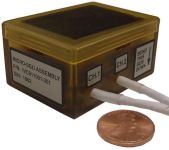
Launched January 16, 2003
Space Shuttle Columbia
The objective of STS-107 was primarily a research mission. The FREESTAR (Fast Reaction Experiments Enabling Science, Technology, Applications & Research) payload is a Hitchhiker payload through the GSFC Code 870 Shuttle Small Payloads Project. FREESTAR consists of separate experiments and the Hitchhiker (HH) Carrier (HHC) avionics mounted on a cross-bay HH Multipurpose Equipment Support Structure (MPESS). The carrier avionics provides the interface to the electrical systems, the payload power control, and command and telemetry capabilities.
Micro-Miniature Strain Gauge Unit

Eleven Invocon MicroSGU™ sensors were installed in the engine compartment to measure the stresses imparted to the trunnion arms on the Space Shuttle Main Engines (SSMEs).
This makes the sixth consecutive flight of the MicroSGU system starting with STS-109.
The MicroSGU is a system of small, battery powered, wirelessly programmable, strain gauge data recorders. Each unit was designed to “sleep” in a low power consumption mode until a certain time set by the user where it will then enter into a circular buffered data trigger mode sampling at 250 Hz using programmable trigger threshold levels. Upon detection of a data trigger, 13 minutes of data is recorded at 250 Hz per channel. Upon completion of the programmed event sequences, the units will enter back into their low power consumption mode to wait for a wireless data download command from the user. Commands are issued via the MicroSGU graphical user interface running on a laptop with the wireless Receiver Unit interface.
- 250Hz Sample Rate
- 2 external sensors per unit
- The units can support any resistive sensor type
- Approximate Size: 5.5cm x 4cm x 2.8cm
View the full MicroSGU Technology Profile (MicroSGU.pdf)
Mission Navigation
